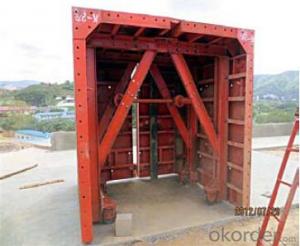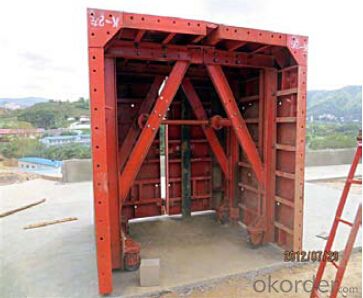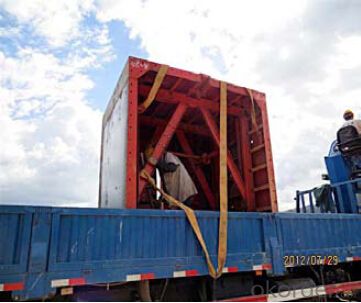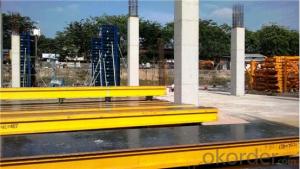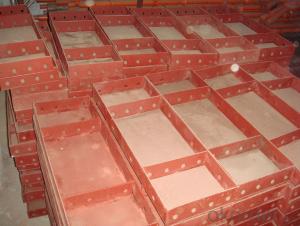Steel-Tunnel for formwork and scaffolding system
- Loading Port:
- Tianjin
- Payment Terms:
- TT OR LC
- Min Order Qty:
- 50 m²
- Supply Capability:
- 1000 m²/month
OKorder Service Pledge
Quality Product, Order Online Tracking, Timely Delivery
OKorder Financial Service
Credit Rating, Credit Services, Credit Purchasing
You Might Also Like
Building Tunnel Formwork:
A compositional steel formwork system mainly used in the building which has regular structure
without beams, the excellent formwork system can make the integral pouring for the wall & slab
easily achieved.
Characteristics:
◆ High stiffness, make perfect shape for concrete.
◆ Easy operation, save labor and force.
◆ Fast forming, repeatedly turnover.
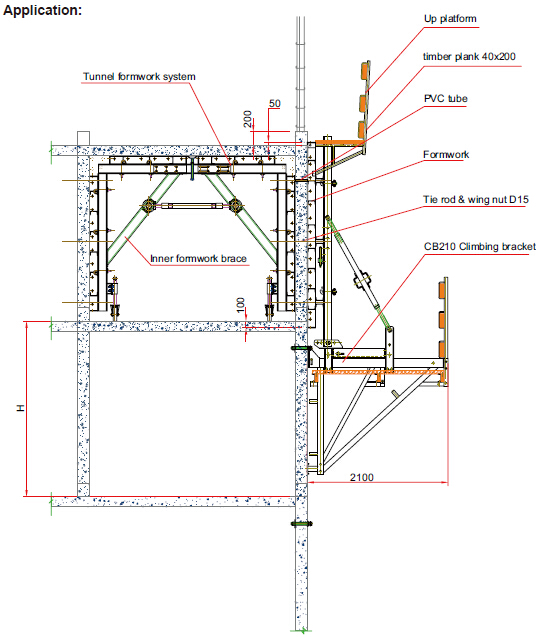
- Q: What are the different safety guidelines for dismantling steel formwork?
- To ensure the protection of workers and prevent accidents, it is important to follow several important safety guidelines when dismantling steel formwork. These guidelines are as follows: 1. Personal Protective Equipment (PPE): Workers involved in the dismantling process must wear appropriate PPE, including safety goggles or glasses, gloves, hard hats, and steel-toed boots. This will safeguard them against potential hazards such as falling debris or sharp edges. 2. Training and Competency: Only individuals who have received proper training and are competent should be assigned to dismantle steel formwork. They should have a thorough understanding of the dismantling process and be aware of the potential risks involved. 3. Safe Work Area: Before commencing the dismantling process, it is necessary to adequately prepare the work area. This involves removing any obstructions or hazards, ensuring a stable and level ground, and demarcating the area to prevent unauthorized access. 4. Tools and Equipment: Workers should utilize appropriate tools and equipment for the dismantling process. This may include wrenches, hammers, cutting tools, and lifting equipment. Tools should be regularly inspected for damage or defects and replaced if necessary. 5. Structural Stability: Prior to dismantling any part of the formwork, workers must ensure that the structure is stable and secure. Temporary supports or bracing may need to be used to prevent any collapse or movement during the dismantling process. 6. Sequential Dismantling: The dismantling of steel formwork should be carried out in a sequential manner, starting from the top and working downwards. This helps maintain the stability of the structure and minimizes the risk of uncontrolled collapses. 7. Controlled Lowering: When dismantling larger steel formwork components, such as panels or beams, they should be lowered in a controlled manner using appropriate lifting equipment. This prevents sudden movements or drops that could cause injuries or damage. 8. Communication and Coordination: Clear communication and coordination between workers involved in the dismantling process are crucial to ensuring everyone's safety. This includes using hand signals, verbal communication, and adhering to a pre-determined plan or procedure. 9. Regular Inspection: Regular inspection of the steel formwork during the dismantling process is important to identify any signs of damage, corrosion, or structural defects. Any issues should be immediately reported and appropriate actions should be taken to address them. 10. Emergency Procedures: Workers should be familiar with emergency procedures in case of accidents or unexpected events. This includes knowing the location of emergency exits, fire extinguishers, and first aid kits, as well as understanding how to respond to incidents such as a collapse or injury. By adhering to these safety guidelines, the risk of accidents and injuries can be significantly reduced during the dismantling of steel formwork. It is crucial to prioritize the safety of workers and ensure that proper precautions are taken at all times.
- Q: What types of concrete structures can be built using steel formwork?
- Steel formwork is versatile and can be used to construct a wide range of concrete structures. Some common examples include walls, columns, beams, slabs, foundations, and even complex structures like bridges and tunnels. The strength and durability of steel formwork make it suitable for projects of varying scales and complexities, offering a sturdy and efficient solution for creating high-quality concrete structures.
- Q: What are the fire resistance properties of steel formwork?
- Steel formwork is renowned for its exceptional fire resistance. Being a non-combustible material, steel does not burn or contribute to the propagation of fire. Its high melting point confers remarkable resistance to heat and flames. In case of a fire, steel formwork remains intact, ensuring the safety of workers and preventing the fire from spreading to other areas. In addition, steel formwork does not release toxic fumes or smoke when exposed to high temperatures, unlike wood or plastic, which are commonly used in construction. This aspect is crucial as toxic fumes can be harmful and impede evacuation efforts during a fire emergency. Moreover, steel formwork exhibits low thermal conductivity, meaning it does not readily transfer heat. This feature helps confine the heat within the fire zone, curbing its spread to adjacent areas. It also diminishes the risk of structural damage caused by material expansion and contraction due to heat exposure. All in all, the fire-resistant properties of steel formwork render it a dependable choice for construction projects, particularly in locations where fire safety is of utmost importance. Its non-combustible nature, high melting point, absence of toxic fumes, and low thermal conductivity collectively contribute to establishing a secure and safeguarded environment in the face of potential fire hazards.
- Q: How does steel formwork handle different concrete segregation tendencies?
- Steel formwork is a highly versatile and durable option for handling different concrete segregation tendencies. Its strength and rigidity allow it to withstand the pressure exerted by the fresh concrete during pouring and vibrating. When dealing with concrete that tends to segregate, steel formwork provides the necessary support and containment to prevent the separation of aggregates from the cement paste. The tight and smooth surface of steel formwork helps in retaining the moisture content within the concrete, preventing excessive water loss that can lead to segregation. Moreover, steel formwork can be easily adjusted and reinforced to accommodate various concrete mix designs and placement techniques. This adaptability allows for the creation of formwork systems that minimize the risk of segregation, ensuring a homogeneous and uniform concrete structure. Another advantage of steel formwork is its resistance to warping and deformation. This characteristic helps in maintaining the shape and stability of the formwork, preventing any potential shifting or movement that could contribute to concrete segregation. Furthermore, steel formwork can be designed with features such as tie rods and braces, which provide additional support and prevent bulging or bowing of the formwork under the pressure of the concrete. This feature is particularly beneficial when dealing with concrete mixtures that have a high tendency to segregate. In summary, steel formwork effectively handles different concrete segregation tendencies by providing robust support, preventing excessive water loss, and offering flexibility and adjustability to accommodate various mix designs. Its strength and stability ensure that the formwork retains the shape and integrity necessary to prevent segregation and produce a high-quality, uniform concrete structure.
- Q: What are the different types of scaffolding used with steel formwork?
- There are several types of scaffolding commonly used with steel formwork, including tube and coupler scaffolding, system scaffolding, and frame scaffolding. Tube and coupler scaffolding consists of steel tubes connected by couplers to form a rigid structure. System scaffolding utilizes pre-engineered components that can be easily assembled, such as modular frames, braces, and platforms. Frame scaffolding involves using vertical frames connected by cross braces and platforms. Each type of scaffolding has its own advantages and is chosen based on factors such as project requirements, ease of assembly, and safety considerations.
- Q: Can steel formwork be used for both reinforced and non-reinforced concrete structures?
- Yes, steel formwork can be used for both reinforced and non-reinforced concrete structures. Steel formwork is a versatile and durable option that can withstand the pressure exerted by the concrete during the casting process. It can be easily assembled and disassembled, making it suitable for various types of construction projects. Whether it is a reinforced structure that requires additional support for the reinforcement bars or a non-reinforced structure that only requires a temporary mold, steel formwork can be used effectively in both cases. Its strength and stability allow for the creation of precise shapes and dimensions, ensuring the desired outcome for any concrete structure.
- Q: What are the considerations when selecting the appropriate steel grade for formwork?
- When selecting the appropriate steel grade for formwork, several considerations should be taken into account. Firstly, the steel grade should have good strength and durability to withstand the loads and pressures exerted during the construction process. It should be able to resist deformation and maintain its structural integrity. Additionally, the steel grade should have good weldability and workability to ensure ease of fabrication and installation. Another important consideration is corrosion resistance, as formwork is often exposed to moisture and chemicals that can lead to rusting and deterioration. Finally, the cost and availability of the steel grade should be considered to ensure that it aligns with the project budget and timeline.
- Q: Can steel formwork withstand extreme weather conditions?
- Yes, steel formwork is designed to withstand extreme weather conditions. Steel is known for its strength and durability, making it highly resistant to harsh weather elements such as heavy rain, strong winds, and high temperatures. Additionally, steel formwork is often treated with protective coatings to further enhance its resistance to corrosion and degradation caused by extreme weather conditions.
- Q: What are the different cost considerations associated with steel formwork?
- There are several cost considerations associated with steel formwork that need to be taken into account when planning a construction project. Firstly, there is the initial cost of purchasing or renting the steel formwork. Steel formwork is generally more expensive than other types of formwork, such as timber or plastic. However, it is important to note that steel formwork is durable and has a longer lifespan, which can offset the initial cost in the long run. Secondly, there are the labor costs associated with assembling and dismantling the steel formwork. Steel formwork requires skilled labor for proper installation and removal, which may incur additional expenses. However, steel formwork is typically faster to set up and dismantle compared to other types of formwork, which can potentially reduce labor costs. Another cost consideration is the maintenance and repair expenses. While steel formwork is known for its durability, it may still require occasional maintenance or repairs to ensure its optimal performance. This can include cleaning, painting, or replacing damaged components. These maintenance costs should be factored into the overall project budget. Additionally, transportation costs should be considered when using steel formwork. Steel formwork is heavy and bulky, requiring special transportation arrangements. This can lead to higher transportation costs compared to lighter and more compact formwork options. Lastly, the cost of formwork accessories, such as connectors, brackets, and ties, should also be taken into account. These accessories are necessary for proper formwork installation and can add to the overall cost of using steel formwork. In conclusion, the different cost considerations associated with steel formwork include the initial purchase or rental cost, labor costs for assembly and dismantling, maintenance and repair expenses, transportation costs, and the cost of formwork accessories. While steel formwork may have higher upfront costs, its durability, speed of installation, and long-term lifespan can provide cost-saving benefits in the long run.
- Q: Are there any specific considerations for using steel formwork in areas with high traffic loads?
- Yes, there are several specific considerations when using steel formwork in areas with high traffic loads. Firstly, the strength and durability of the steel formwork should be carefully evaluated to ensure that it can withstand the heavy loads and constant traffic. Steel formwork is known for its high strength and load-bearing capacity, making it suitable for such applications. However, it is important to choose the right type and grade of steel that can withstand the specific traffic loads in the area. Secondly, the design and construction of the formwork system should be done by experienced professionals who understand the requirements of high traffic loads. Proper reinforcement and bracing should be incorporated to provide additional strength and stability to the formwork structure. This may include using additional steel supports or beams to distribute the loads more effectively. Additionally, the connections and joints between different formwork elements should be carefully designed and constructed to ensure they can withstand the heavy traffic loads without any failure. Welding or bolting techniques may be used to enhance the structural integrity of the formwork system. Furthermore, regular inspection and maintenance of the steel formwork should be carried out to identify any signs of wear and tear or damage caused by the high traffic loads. Any damaged or weakened sections should be repaired or reinforced promptly to avoid any safety hazards. Lastly, it is important to consider the impact of the high traffic loads on the concrete being poured into the formwork. The concrete mix and pouring techniques should be carefully chosen to ensure they can withstand the dynamic loads caused by heavy traffic. Reinforcement measures such as using steel rebar or fiber reinforcement can also be considered to enhance the strength and durability of the concrete. In conclusion, when using steel formwork in areas with high traffic loads, it is essential to consider the strength and durability of the formwork, design and construction techniques, connections and joints, regular inspection and maintenance, as well as the impact on the concrete. By taking these specific considerations into account, the steel formwork can provide a safe and reliable solution for construction projects in high traffic areas.
Send your message to us
Steel-Tunnel for formwork and scaffolding system
- Loading Port:
- Tianjin
- Payment Terms:
- TT OR LC
- Min Order Qty:
- 50 m²
- Supply Capability:
- 1000 m²/month
OKorder Service Pledge
Quality Product, Order Online Tracking, Timely Delivery
OKorder Financial Service
Credit Rating, Credit Services, Credit Purchasing
Similar products
Hot products
Hot Searches
Related keywords
